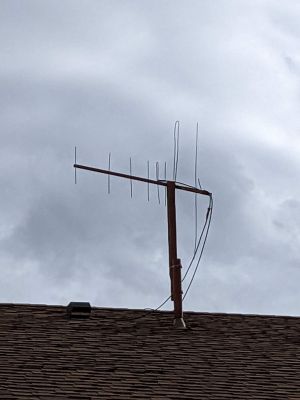VHF and UHF antennas
DIY Vertical antennas
If you want a simple omni-directional antenna, it's hard to beat a vertical. Advantageous over a dipole for focusing the signal more toward the horizon, they are simple to build and are usually sufficient for most vhf/uhf needs. There are lots of sites on the internet telling you how to calculate the length of the elements so I won't duplicate that here. My technique is to start with a quarter wavelength for the frequency you want, then connect an antenna analyzer (or in recent years, a nano-VNA) and trim until it resonates where you like.

Here's a design I came up with recently. It uses a chassis mount SO-239 connector with the elements soldered directly on. First I solder on the vertical element, then I solder on a piece of 1/2 copper pipe to go around it as a strain relief. Then solder/bolt on the radials. At the end, I fill the copper pipe up with epoxy. This gives a nice strain relief and has proven quite robust out in the elements. BTW it is important to at least paint the epoxy to protect it from UV.
DIY Yagi antennas
I ran across this design and I think it's really clever - a yagi with no gamma/hairpin match needed. It's designed for simple and quick construction. I've had it up for a couple years and it's worked really well. He has a couple excellent articles on this, search the following link for "Cheap yagi"
https://www.wa5vjb.com/references.html

900 antenna
I made this to get on the 900 Mhz ham band. Simple antenna to build from an "N" chassis mount connector. I have it sitting on top a 3/4 PVC pipe which is attached to the eaves of my roof.

1090 antenna
Not strictly ham radio, but 1090 is the frequency aircraft use to reply to ground based radar (mode A/C) as well as "extended squitter" mode S, usually carrying ADSB data. This particular antenna is used in one of my gliders to receive ADSB on PowerFLARM for collision avoidance. It's a dipole antenna and while a dipole is a poor match to a 50 ohm unbalanced feed, it's good enough to pick up aircraft within the range you care about. ADSB signals are broadcast with quite a bit of power so even a marginal antenna will pick them up from quite a distance.

The NanoVNA is a great tool for cutting antennas to length. Calculate the lengths to get it close, then trim as needed to nail the resonant point. I think these are so cool - so much functionality for so cheap! Obviously they don't have the dynamic range of a more expensive VNA but it's plenty good enough for a lot of projects.
